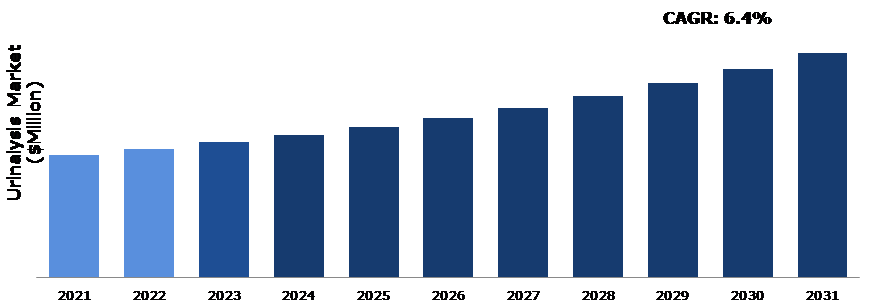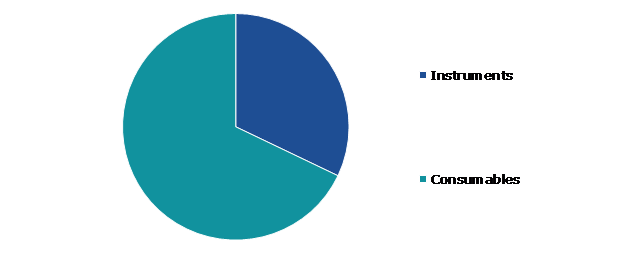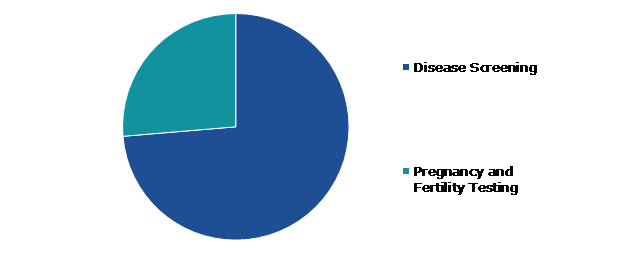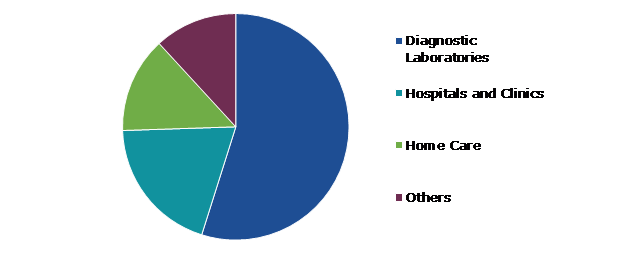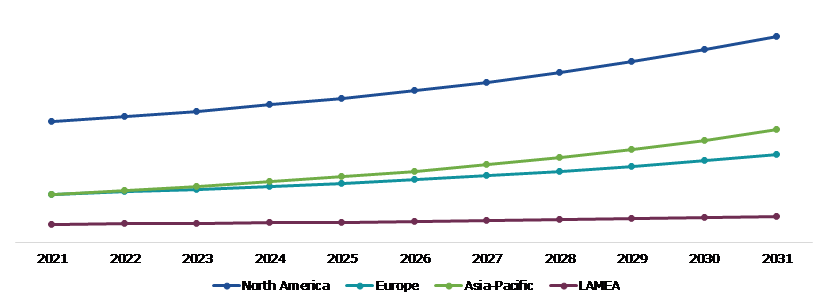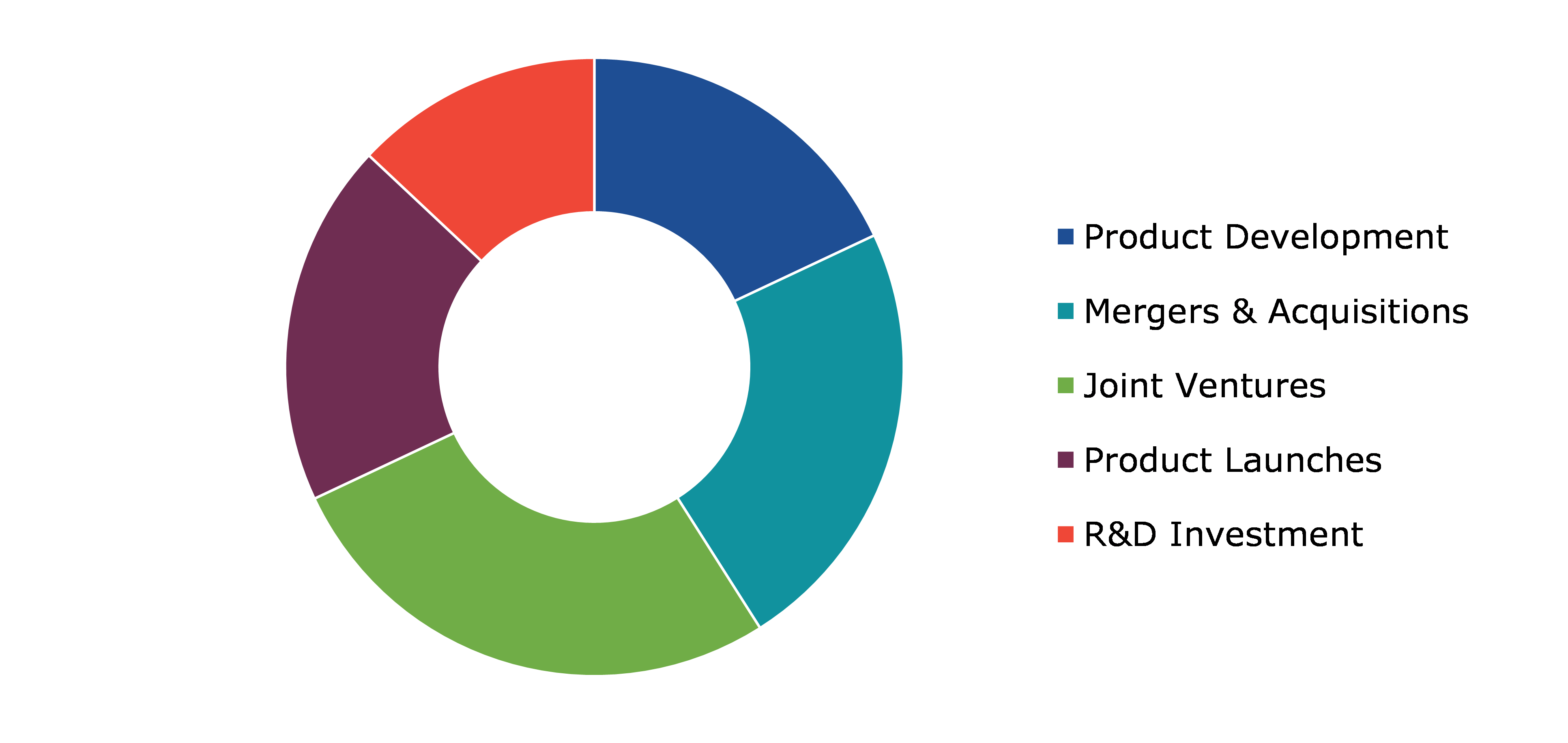Urinalysis Market Report
RA01230
Urinalysis Market by Product Type (Instruments and Consumables), Application (Disease Screening and Pregnancy & Fertility Testing), End-user (Diagnostic Laboratories, Hospitals & Clinics, Home Care, and Others), and Regional Analysis (North America, Europe, Asia-Pacific, and LAMEA): Global Opportunity Analysis and Industry Forecast, 2022-2031
Global Urinalysis Market Analysis
The Global Urinalysis Market Size was $3,117.7 million in 2021 and is predicted to grow with a CAGR of 6.4%, by generating a revenue of $5.719.3 million by 2031.
Global Urinalysis Market Synopsis
Urinalysis refers to urine analysis. It is used to detect and treat a wide range of conditions, including urinary tract infections, kidney disease, and diabetes. Urinalysis examines the appearance, concentration, and content of urine. The urine analysis market is expanding due to factors such as the rising prevalence of diseases such as urinary tract infections (UTIs), diabetes, and kidney diseases. The increasing use of automated and advanced UTIs testing technology According to the National Diabetes Statistics Report, 2020, approximately 34.2 million people in the United States aged 18 and up had diabetes. Due to high blood sugar and blood pressure, approximately one-third of diabetics have kidney-related comorbidities. Urinalysis is a noninvasive diagnostic tool that clinicians can use to diagnose kidney diseases. As a result, the rising prevalence of kidney diseases is expected to increase demand for urinalysis products, thereby driving market growth. Urinalysis is used to detect drug abuse and monitor the progress of drug treatment, while pregnancy testing involves the detection of the human chorionic gonadotropin (HCG) hormone in urine. These factors are anticipated to boost the urinalysis industry growth in the upcoming years.
Despite the availability of advanced urinalysis tests, such as fully automated analyzers and point-of-care devices, some healthcare providers still rely on traditional manual methods, which are the key factors expected to hamper the market growth during the forecast period. Moreover, usage of refurbished urine analyzers in developing countries, which are price-sensitive, compromises on the quality which is also anticipated to act as a restraint. In the absence of well-grounded regulatory frameworks, there may be an influx of low quality and refurbished products into the economy.
Urinalysis is widely used in the diagnosis and treatment of diseases for kidney and liver. Urinalysis allows clinicians to assess the level of chemical compounds in urine. These factors will propel market growth. Furthermore, the high disease prevalence, large patient population, improving healthcare infrastructure, increasing disposable income, and growing medical tourism in emerging countries all play an important role in upgrading laboratory infrastructure.
According to regional analysis, the North America urinalysis market accounted for the largest market share in 2021. North America has a rising prevalence of chronic kidney diseases, urinary tract infections, and other kidney-related disorders. The increasing awareness about the importance of early diagnosis and management of such diseases is also driving the demand for urinalysis tests. Furthermore, the increasing focus on preventive healthcare and the rising investments in healthcare infrastructure is expected to create significant growth opportunities for the urinalysis market share in the North America region.
Urinalysis Overview
Urinalysis, also known as urine test, examines the visual, chemical, and microscopic components of urine. It entails inspecting the appearance, concentration, and content of urine. It includes a number of tests that detect and measure various compounds that pass-through urine using a single urine sample. Urinalysis is used to diagnose and treat a variety of illnesses, including diabetes, kidney diseases, and urogenital infections.
COVID-19 Impact on Global Urinalysis Market
The COVID-19 outbreak had a significant impact on the growth of the urinalysis market. Many businesses around the world were closed for an extended period of time, causing economic disruption. Rising coronavirus cases primarily impacted the elderly and patients who already had chronic diseases. Many deaths were caused by a lack of proper medical treatment, inadequate testing equipment, and their high market demand. Acute kidney injury (AKI) in COVID-19 patients is common and can range from proteinuria and hematuria to acute kidney injury (AKI). Urinalysis and AKI biomarkers are frequently abnormal in COVID-19 patients and may characterize AKI in these patients. As a result, studies are being conducted to investigate the changing biochemical parameters in depth. For instance, according to an article published in Nature Reviews Nephrology in October 2020, the urinalysis study using dipsticks found that 42.1% of COVID-19 patients hospitalized with urinalysis had significant proteinuria, with leukocyturia and hematuria in 36.5% and 40.9%, respectively. In addition, proteinuria was found in 43.9% of 442 hospitalized Chinese patients with COVID-19.
Increasing Prevalence of Urinary Tract Infections to Drive the Market Growth
The prevalence of urinary tract infections (UTIs) is increasing globally, particularly among women. As a result, the demand for urinalysis is increasing as it helps in the early detection and treatment of UTIs. Moreover, the rising incidence of chronic kidney diseases and diabetes, which can also lead to urinary tract problems, is contributing to the growth of the urinalysis market. The increasing awareness among people about the importance of regular health check-ups and the availability of advanced diagnostic tests is also driving market growth. The increasing prevalence of urinary tract infections, chronic kidney diseases, and diabetes, coupled with the growing adoption of point-of-care testing devices and home testing kits, are driving the growth of the urinalysis market. Furthermore, the increasing use of urinalysis in drug testing and pregnancy testing is also boosting market growth. Additionally, the growing adoption of point-of-care testing devices and home testing kits for urinalysis are further propelling the market growth. The market is expected to continue growing in the coming years due to the increasing focus on preventive healthcare and the availability of advanced diagnostic tests.
To know more about global urinalysis market drivers, get in touch with our analysts here.
Lack of Standardization in Tests Across Deferent Laboratories to Restrain the Market Growth
Urinalysis testing can vary depending on the method used, which can lead to inconsistent results and make it difficult to compare results across different laboratories. The lack of standardization can also affect the accuracy of test results. Additionally, the interpretation of urinalysis results can vary among healthcare providers, leading to potential misdiagnoses or missed diagnoses. This lack of standardization can hinder the development of new urinalysis testing methods and limit their widespread adoption in clinical settings. Furthermore, the lack of clear guidelines for urinalysis testing can make it challenging for manufacturers to design and produce accurate and reliable testing equipment. As a result, this may restrict the growth of the urinalysis market, limiting its potential to improve patient care and outcomes, which is anticipated to hamper the urinalysis market growth.
Growing Demand for Point-of-Care Testing to Drive Excellent Opportunities
Urinalysis is widely used as a point-of-care diagnostic test in various healthcare settings. With the increasing prevalence of chronic diseases and the need for timely diagnosis and treatment, the demand for point-of-care testing is expected to rise. This is expected to boost the urinalysis market growth. In addition, the availability of advanced technologies and devices for urinalysis testing, such as dipsticks and urine analyzers, has made it easier for healthcare professionals to perform rapid and accurate tests at the point of care. This has further driven the adoption of urinalysis as a diagnostic tool in emergency departments, primary care clinics, and nursing homes, especially as healthcare systems worldwide continue to shift towards decentralized and patient-centered care models. These factors are growing the demand for point-of-care testing and are expected to create significant opportunities for the urinalysis market.
To know more about global urinalysis market opportunities, get in touch with our analysts here.
Global Urinalysis Market, by Product Type
Based on product type, the market has been divided into instruments and consumables. Among these, the consumables sub-segment accounted for the highest market share in 2021, whereas the instruments sub-segment is estimated to show the fastest growth during the forecast period.
Global Urinalysis Market Share, by Product Type, 2021
Source: Research Dive Analysis
The consumables sub-type accounted for the largest market share in 2021. This is because the consumables used in urinalysis, such as reagent strips, urine sediment analyzers, and other assay kits, are regularly used in laboratories and clinics. The consumables segment includes products that are used in both the manual and automated analysis of urine samples. Additionally, the growing awareness about the importance of early diagnosis and prevention of diseases has increased the use of urinalysis tests in routine health check-ups. The increasing prevalence of urinary tract infections, kidney disorders, and other urinary diseases has led to a rise in the demand for urinalysis tests. The consumables segment of the Urinalysis market share is expected to continue growing due to the increasing demand for accurate and rapid diagnosis of urinary diseases.
The instruments sub-type is anticipated to show the fastest growth in 2031. The instruments segment is a major driver of the urinalysis market demand as it includes various devices such as analyzers, reagent strips, dipsticks, urine sediment analyzers, and microscopes used to perform urinalysis tests. These instruments are used in hospitals, clinics, diagnostic laboratories, and research centers for the diagnosis and management of various urinary tract disorders and diseases such as urinary tract infections, kidney diseases, and bladder cancer. Additionally, the development of technologically advanced instruments with improved accuracy, sensitivity, and specificity, and the increasing focus of manufacturers on product innovation and development are also expected to drive the growth of this segment in the coming years.
Global Urinalysis Market, by Application
Based on application, the market has been divided into disease screening and pregnancy & fertility testing. Among these, the disease screening sub-segment accounted for highest revenue share in 2021.
Global Urinalysis Market Size, by Application, 2021
Source: Research Dive Analysis
The disease screening sub-segment accounted for the largest market share in 2021. Urinalysis is a commonly used diagnostic tool to screen for various diseases such as urinary tract infections, kidney diseases, diabetes, and liver diseases. The rising prevalence of these diseases, along with the increasing aging population, is expected to drive the demand for urinalysis tests. Moreover, advancements in technology have led to the development of highly accurate and easy-to-use urinalysis devices that are expected to further increase the adoption of these tests. Furthermore, the increasing focus on preventive healthcare and growing awareness about the importance of early disease detection are factors anticipated to boost the growth of the disease screening sub-segment during the analysis timeframe.
Global Urinalysis Market, by End-User
Based on end-user, the market has been divided into diagnostic laboratories, hospitals & clinics, home care and others. Among these, the diagnostic laboratories sub-segment accounted for highest revenue share in 2021.
Global Urinalysis Market Growth, by End-User, 2021
Source: Research Dive Analysis
The diagnostic laboratories sub-segment accounted for the largest market share in 2021. The diagnostic laboratories segment of the urinalysis market includes medical laboratories and clinical diagnostic laboratories that offer specialized urine testing services. These laboratories use advanced diagnostic tools and techniques to analyze urine samples and provide accurate results to healthcare providers for the diagnosis and treatment of various diseases. The urinalysis market analysis has seen significant growth in recent years, driven by the increasing prevalence of chronic kidney diseases, urinary tract infections, and other urological disorders. As a result, the demand for urine analysis has increased, leading to a rise in the number of diagnostic laboratories offering urine testing services. These factors are anticipated to boost the growth of diagnostic laboratories sub-segment during the analysis timeframe.
Global Urinalysis Market, Regional Insights
The urinalysis market was investigated across North America, Europe, Asia-Pacific, and LAMEA.
Global Urinalysis Market Size & Forecast, by Region, 2021-2031 (USD Million)
Source: Research Dive Analysis
The Market for Urinalysis in North America was the Most Dominant
The North America urinalysis market accounted for the largest market share in 2021. The increasing prevalence of chronic diseases such as diabetes and kidney disorders, the growing geriatric population, and the rising demand for point-of-care testing are some of the key factors contributing to the growth of the urinalysis market in the North America region. Moreover, the region has a well-established healthcare infrastructure, favorable reimbursement policies, and high adoption of advanced technologies, which further support the growth of the urinalysis market. Moreover, the advancements in technology and the availability of portable and user-friendly devices are further boosting the adoption of urinalysis tests in the region. Furthermore, the increasing focus of healthcare organizations on preventive healthcare and the growing trend of home-based healthcare are expected to create lucrative opportunities for market players in the region. However, high costs associated with advanced urinalysis tests and the lack of skilled professionals may hinder the market growth to some extent. The growing demand for point-of-care testing and the rising adoption of telehealth services are also fueling the growth of the urinalysis market in North America. Furthermore, the availability of advanced diagnostic tools are expected to boost the demand for urinalysis tests in the region.
Competitive Scenario in the Global Urinalysis Market
Investment and agreement are common strategies followed by major market players. For instance, in August 2020, In the UK, the TestCard non-invasive at-home UTI test kit was released. The companion smartphone app allows consumers to view testing results and communicate information with a healthcare practitioner. This test kit may be purchased at a retail drugstore for $12.06.
Source: Research Dive Analysis
Some of the leading urinalysis market players are Abbott, Sysmex Corporation, Siemens Healthcare Gmbh, ACON Laboratories, Inc., ARKRAY Inc, Shenzhen Mindray Bio-Medical Electronics Co., Ltd., F. Hoffmann-La Roche Ltd, Quidel Corporation, and Bio-Rad Laboratories, Inc., Teco Diagnostics
| Aspect | Particulars |
| Historical Market Estimations | 2020 |
| Base Year for Market Estimation | 2021 |
| Forecast Timeline for Market Projection | 2022-2031 |
| Geographical Scope | North America, Europe, Asia-Pacific, LAMEA |
| Segmentation by Product Type |
|
| Segmentation by Application |
|
| Segmentation by End-User |
|
| Key Companies Profiled |
|
Q1. What is the size of the global urinalysis market?
A. The size of the global urinalysis market size was over $3,117.7 million in 2021 and is projected to reach $5,719.3 million by 2031.
Q2. Which are the major companies in the urinalysis market?
A. Abbott, Sysmex Corporation, and Siemens Healthcare Gmbh are some of the key players in the global urinalysis market.
Q3. Which region, among others, possesses greater investment opportunities in the near future?
A. The Asia-Pacific region possesses great investment opportunities for investors to witness the most promising growth in the future.
Q4. What will be the growth rate of the Asia-Pacific urinalysis market?
A. Asia-Pacific urinalysis market is anticipated to grow at 8.9% CAGR during the forecast period.
Q5. What are the strategies opted by the leading players in this market?
A. Agreement and investment are the two key strategies opted by the operating companies in this market.
Q6. Which companies are investing more on R&D practices?
A. ACON Laboratories, Shenzhen Mindray Bio-Medical Electronics Co., Ltd., and F. Hoffmann-La Roche Ltd. are the companies investing more on R&D activities for developing new products and technologies.
1.Research Methodology
1.1.Desk Research
1.2.Real time insights and validation
1.3.Forecast model
1.4.Assumptions and forecast parameters
1.5.Market size estimation
1.5.1.Top-down approach
1.5.2.Bottom-up approach
2.Report Scope
2.1.Market definition
2.2.Key objectives of the study
2.3.Report overview
2.4.Market segmentation
2.5.Overview of the impact of COVID-19 on Global urinalysis market
3.Executive Summary
4.Market Overview
4.1.Introduction
4.2.Growth impact forces
4.2.1.Drivers
4.2.2.Restraints
4.2.3.Opportunities
4.3.Market value chain analysis
4.3.1.List of raw material suppliers
4.3.2.List of manufacturers
4.3.3.List of distributors
4.4.Innovation & sustainability matrices
4.4.1.Technology matrix
4.4.2.Regulatory matrix
4.5.Porter’s five forces analysis
4.5.1.Bargaining power of suppliers
4.5.2.Bargaining power of consumers
4.5.3.Threat of substitutes
4.5.4.Threat of new entrants
4.5.5.Competitive rivalry intensity
4.6.PESTLE analysis
4.6.1.Political
4.6.2.Economical
4.6.3.Social
4.6.4.Technological
4.6.5.Environmental
4.7.Impact of COVID-19 on urinalysis market
4.7.1.Pre-covid market scenario
4.7.2.Post-covid market scenario
5.Urinalysis Market Analysis, by Product Type
5.1.Overview
5.2.Instruments
5.2.1.Definition, key trends, growth factors, and opportunities
5.2.2.Market size analysis, by region, 2021-2031
5.2.3.Market share analysis, by country, 2021-2031
5.3.Consumables
5.3.1.Definition, key trends, growth factors, and opportunities
5.3.2.Market size analysis, by region, 2021-2031
5.3.3.Market share analysis, by country, 2021-2031
5.4.Research Dive Exclusive Insights
5.4.1.Market attractiveness
5.4.2.Competition heatmap
6.Urinalysis Market Analysis, by Application
6.1.Disease Screening
6.1.1.Definition, key trends, growth factors, and opportunities
6.1.2.Market size analysis, by region, 2021-2031
6.1.3.Market share analysis, by country, 2021-2031
6.2.Pregnancy and Fertility Testing
6.2.1.Definition, key trends, growth factors, and opportunities
6.2.2.Market size analysis, by region, 2021-2031
6.2.3.Market share analysis, by country, 2021-2031
6.3.Research Dive Exclusive Insights
6.3.1.Market attractiveness
6.3.2.Competition heatmap
7.Urinalysis Market Analysis, by End-User
7.1.Diagnostic Laboratories
7.1.1.Definition, key trends, growth factors, and opportunities
7.1.2.Market size analysis, by region, 2021-2031
7.1.3.Market share analysis, by country, 2021-2031
7.2.Hospitals and Clinics
7.2.1.Definition, key trends, growth factors, and opportunities
7.2.2.Market size analysis, by region, 2021-2031
7.2.3.Market share analysis, by country, 2021-2031
7.3.Home Care
7.3.1.Definition, key trends, growth factors, and opportunities
7.3.2.Market size analysis, by region, 2021-2031
7.3.3.Market share analysis, by country, 2021-2031
7.4.Others
7.4.1.Definition, key trends, growth factors, and opportunities
7.4.2.Market size analysis, by region, 2021-2031
7.4.3.Market share analysis, by country, 2021-2031
7.5.Research Dive Exclusive Insights
7.5.1.Market attractiveness
7.5.2.Competition heatmap
8.Urinalysis Market, by Region
8.1.North America
8.1.1.U.S.
8.1.1.1.Market size analysis, by Product Type, 2021-2031
8.1.1.2.Market size analysis, by Application, 2021-2031
8.1.1.3.Market size analysis, by End-User, 2021-2031
8.1.2.Canada
8.1.2.1.Market size analysis, by Product Type, 2021-2031
8.1.2.2.Market size analysis, by Application, 2021-2031
8.1.2.3.Market size analysis, by End-User, 2021-2031
8.1.3.Mexico
8.1.3.1.Market size analysis, by Product Type, 2021-2031
8.1.3.2.Market size analysis, by Application, 2021-2031
8.1.3.3.Market size analysis, by End-User, 2021-2031
8.1.4.Research Dive Exclusive Insights
8.1.4.1.Market attractiveness
8.1.4.2.Competition heatmap
8.2.Europe
8.2.1.Germany
8.2.1.1.Market size analysis, by Product Type, 2021-2031
8.2.1.2.Market size analysis, by Application, 2021-2031
8.2.1.3.Market size analysis, by End-User, 2021-2031
8.2.2.UK
8.2.2.1.Market size analysis, by Product Type, 2021-2031
8.2.2.2.Market size analysis, by Application, 2021-2031
8.2.2.3.Market size analysis, by End-User, 2021-2031
8.2.3.France
8.2.3.1.Market size analysis, by Product Type, 2021-2031
8.2.3.2.Market size analysis, by Application, 2021-2031
8.2.3.3.Market size analysis, by End-User, 2021-2031
8.2.4.Spain
8.2.4.1.Market size analysis, by Product Type, 2021-2031
8.2.4.2.Market size analysis, by Application, 2021-2031
8.2.4.3.Market size analysis, by End-User, 2021-2031
8.2.5.Italy
8.2.5.1.Market size analysis, by Product Type, 2021-2031
8.2.5.2.Market size analysis, by Application, 2021-2031
8.2.5.3.Market size analysis, by End-User, 2021-2031
8.2.6.Rest of Europe
8.2.6.1.Market size analysis, by Product Type, 2021-2031
8.2.6.2.Market size analysis, by Application, 2021-2031
8.2.6.3.Market size analysis, by End-User, 2021-2031
8.2.7.Research Dive Exclusive Insights
8.2.7.1.Market attractiveness
8.2.7.2.Competition heatmap
8.3.Asia Pacific
8.3.1.China
8.3.1.1.Market size analysis, by Product Type, 2021-2031
8.3.1.2.Market size analysis, by Application, 2021-2031
8.3.1.3.Market size analysis, by End-User, 2021-2031
8.3.2.Japan
8.3.2.1.Market size analysis, by Product Type, 2021-2031
8.3.2.2.Market size analysis, by Application, 2021-2031
8.3.2.3.Market size analysis, by End-User, 2021-2031
8.3.3.India
8.3.3.1.Market size analysis, by Product Type, 2021-2031
8.3.3.2.Market size analysis, by Application, 2021-2031
8.3.3.3.Market size analysis, by End-User, 2021-2031
8.3.4.Australia
8.3.4.1.Market size analysis, by Product Type, 2021-2031
8.3.4.2.Market size analysis, by Application, 2021-2031
8.3.4.3.Market size analysis, by End-User, 2021-2031
8.3.5.South Korea
8.3.5.1.Market size analysis, by Product Type, 2021-2031
8.3.5.2.Market size analysis, by Application, 2021-2031
8.3.5.3.Market size analysis, by End-User, 2021-2031
8.3.6.Rest of Asia Pacific
8.3.6.1.Market size analysis, by Product Type, 2021-2031
8.3.6.2.Market size analysis, by Application, 2021-2031
8.3.6.3.Market size analysis, by End-User, 2021-2031
8.3.7.Research Dive Exclusive Insights
8.3.7.1.Market attractiveness
8.3.7.2.Competition heatmap
8.4.LAMEA
8.4.1.Brazil
8.4.1.1.Market size analysis, by Product Type, 2021-2031
8.4.1.2.Market size analysis, by Application, 2021-2031
8.4.1.3.Market size analysis, by End-User, 2021-2031
8.4.2.Saudi Arabia
8.4.2.1.Market size analysis, by Product Type, 2021-2031
8.4.2.2.Market size analysis, by Application, 2021-2031
8.4.2.3.Market size analysis, by End-User, 2021-2031
8.4.3.UAE
8.4.3.1.Market size analysis, by Product Type, 2021-2031
8.4.3.2.Market size analysis, by Application, 2021-2031
8.4.3.3.Market size analysis, by End-User, 2021-2031
8.4.4.South Africa
8.4.4.1.Market size analysis, by Product Type, 2021-2031
8.4.4.2.Market size analysis, by Application, 2021-2031
8.4.4.3.Market size analysis, by End-User, 2021-2031
8.4.5.Rest of LAMEA
8.4.5.1.Market size analysis, by Product Type, 2021-2031
8.4.5.2.Market size analysis, by Application, 2021-2031
8.4.5.3.Market size analysis, by End-User, 2021-2031
8.4.6.Research Dive Exclusive Insights
8.4.6.1.Market attractiveness
8.4.6.2.Competition heatmap
9.Competitive Landscape9.1.Top winning strategies, 2021
9.1.1.By strategy
9.1.2.By year
9.2.Strategic overview
9.3.Market share analysis, 2021
10.Company Profiles
10.1.Abbott
10.1.1.Overview
10.1.2.Business segments
10.1.3.Product portfolio
10.1.4.Financial performance
10.1.5.Recent developments
10.1.6.SWOT analysis
10.2.Sysmex Corporation
10.2.1.Overview
10.2.2.Business segments
10.2.3.Product portfolio
10.2.4.Financial performance
10.2.5.Recent developments
10.2.6.SWOT analysis
10.3.Siemens Healthcare Gmbh
10.3.1.Overview
10.3.2.Business segments
10.3.3.Product portfolio
10.3.4.Financial performance
10.3.5.Recent developments
10.3.6.SWOT analysis
10.4.ACON Laboratories
10.4.1.Overview
10.4.2.Business segments
10.4.3.Product portfolio
10.4.4.Financial performance
10.4.5.Recent developments
10.4.6.SWOT analysis
10.5.ARKRAY Inc
10.5.1.Overview
10.5.2.Business segments
10.5.3.Product portfolio
10.5.4.Financial performance
10.5.5.Recent developments
10.5.6.SWOT analysis
10.6.Shenzhen Mindray Bio-Medical Electronics Co., Ltd.
10.6.1.Overview
10.6.2.Business segments
10.6.3.Product portfolio
10.6.4.Financial performance
10.6.5.Recent developments
10.6.6.SWOT analysis
10.7.F. Hoffmann-La Roche Ltd.
10.7.1.Overview
10.7.2.Business segments
10.7.3.Product portfolio
10.7.4.Financial performance
10.7.5.Recent developments
10.7.6.SWOT analysis
10.8.Quidel Corporation
10.8.1.Overview
10.8.2.Business segments
10.8.3.Product portfolio
10.8.4.Financial performance
10.8.5.Recent developments
10.8.6.SWOT analysis
10.9.Bio-Rad Laboratories, Inc.
10.9.1.Overview
10.9.2.Business segments
10.9.3.Product portfolio
10.9.4.Financial performance
10.9.5.Recent developments
10.9.6.SWOT analysis
10.10.Teco Diagnostics
10.10.1.Overview
10.10.2.Business segments
10.10.3.Product portfolio
10.10.4.Financial performance
10.10.5.Recent developments
10.10.6.SWOT analysis
Urinalysis is a medical test usually done to check for ailments like kidney malfunctioning, diabetes, urinary tract infections, etc. Urinalysis generally involves testing urine for several parameters including its color, odor, pH level, appearance, etc. Also, the patient’s urine is checked if there are any bacteria, fungi, blood traces, protein traces, cells and crystals, etc., are present in it. Urinalysis is one of the most common tests done before any medical treatment or medication is prescribed by the doctor.
Forecast Analysis of the Urinalysis Market
In recent years, there has been an increase in the prevalence of urinary tract infections across the globe which is expected to be the primary growth driver of the global urinalysis market in the forecast years. Along with this, growing demand for point-of-care testing is expected to push the market further. Also, rising global patient population and improving healthcare infrastructure is predicted to offer numerous investment and growth opportunities to the market in the analysis timeframe. However, lack of standardization in tests may restrain the growth of the urinalysis market in the forecast period.
Geographically, the urinalysis market in the North America region is expected to be the most dominant by 2031. The growing geriatric population across the region is anticipated to become the main growth driver of the market in the forecast period.
According to the report published by Research Dive, the global urinalysis market is expected to gather a revenue of $5,719.3 million by 2031 and grow at 6.4% CAGR in the 2022-2031 timeframe. Some prominent market players include Abbott, ARKRAY Inc, Quidel Corporation, Sysmex Corporation, ARKRAY Inc, Bio-Rad Laboratories, Inc., Siemens Healthcare Gmbh, F. Hoffmann-La Roche Ltd, F. Hoffmann-La Roche Ltd, ACON Laboratories, Inc., and many others.
Covid-19 Impact on the Urinalysis Market
The outbreak of the Covid-19 pandemic has had a massive negative effect on almost all industries and businesses across the world. The urinalysis market, however, was an exception. As the pandemic spread across the world, the demand for urinalysis increased for ascertaining the ailment and prescribing appropriate treatment for the patient. This increased demand helped the market to post growth numbers despite the pandemic.
Significant Market Developments
The significant companies operating in the industry are adopting numerous growth strategies & business tactics such as partnerships, collaborations, mergers & acquisitions, and launches to maintain a robust position in the overall market, thus helping the urinalysis market to flourish. For instance:
- In June 2020, Healthy.io, an Israeli urinalysis and wound-care company, announced the acquisition of Inui Health, a medical diagnostics firm. This acquisition is predicted to boost the market share of the acquiring company i.e., Healthy.io in the near future.
- In September 2021, Beckman Coulter, a biomedical products manufacturer, announced the launch of its innovative urinalysis solution, viz., DxU Iris Workcell. DxU Iris Workcell, a fully automated system, has been shown to reduce the subjectivity and variability in urinalysis tests. The product launch is expected to help the company to increase its market share in the coming period and establish itself as a leader in the industry.
- In September 2022, Sysmex Corporation, a medical company, announced the launch of UF-1500 Fully Automated Urine Particle Analyzer (UF-1500). This product is designed for urine sediment testing, an important component of urinalysis, and the product launch is predicted to help the company to cater to the demands of the medical sector in a holistic manner.
Personalize this research
- Triangulate with your own data
- Request your format and definition
- Get a deeper dive on a specific application, geography, customer or competitor
- + 1-888-961-4454 Toll - Free
- support@researchdive.com

